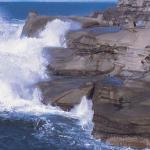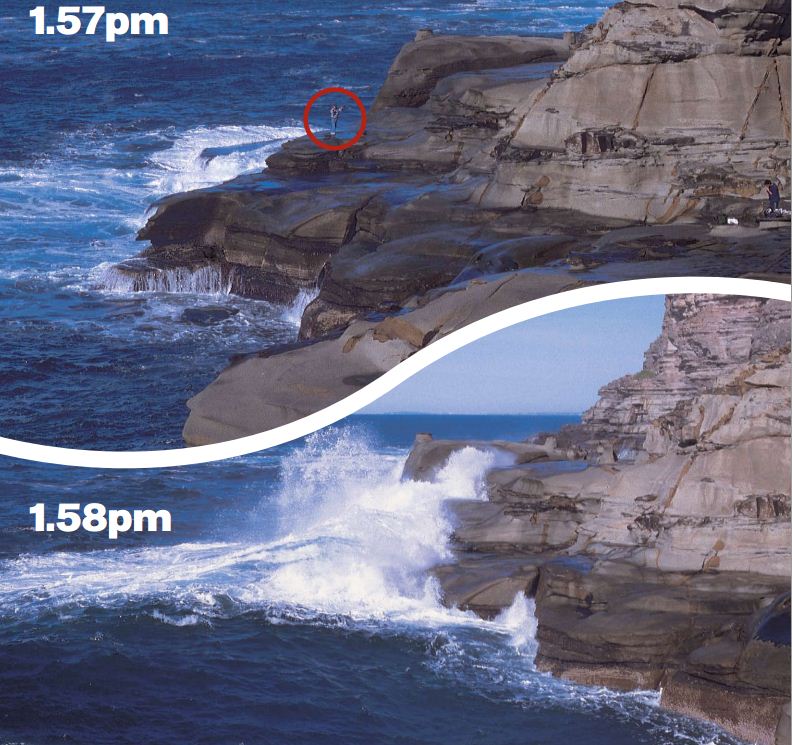Waves from distant storms: a fatal combination for Australia’s rock fishers
16 July 2014
It’s a beautiful calm day on the coast, sun glinting off the water, a cool breeze blowing in from the sea. Perfect fishing weather – or so you would think…
The sea may appear calm to a group of rock fishermen when they arrive at the carpark near their local rock fishing spot. But within the waves, a killer lurks: a giant ocean swell, spawned by a storm hundreds of kilometres out in the Pacific, is generating powerful waves that arrive in irregular ‘sets’ – swamping beaches and rock platforms, and posing a deadly threat to the rock fishermen.
For many years, marine authorities, fishing and life saving associations, especially those along the east coast of Australia, have watched with growing alarm as dozens of rock fishermen lose their lives often in deceptively calm conditions. In the Randwick Council area of southern Sydney, for example, six people have died while fishing on the area’s notorious rock platforms since September 2011.The NSW Government is now considering a proposal to make the wearing of life jackets mandatory for all rock fishers.
Rock fishers are often at risk from the very conditions they seek out. Fishing on rocky headlands provides a chance to catch some of the larger migratory fish species usually only accessible by boat. Fish tend to be more active when the tide is changing, and some of the most popular species, such as bream and rock blackfish, are actually drawn to the rougher ‘whitewater’ around rocks.
Calm conditions does not mean safe
Dangerous swells and waves on Australia’s east coast are typically generated by low-pressure weather systems. During intense local storms, such as East Coast Lows, very rough seas are usually accompanied by gale force winds and driving rain – conditions that are clearly not suitable for fishing.
But there’s a more deceptive situation, when a low pressure weather system far out in the Pacific or the Southern Ocean may be generating local waves of 2 to 4 metres or more. These swells can travel for days and many hundreds of kilometres from where they were formed – losing their height but stretching out and keeping their power.
While they’re in deep water, these long, low swells are not a problem, but as they approach shallow water they break powerfully. Because the systems that generate these waves can be far off to the east, or far south of Australia, they do not always appear on local weather charts – and the swells can arrive when it is sunny and calm.
Another source of danger is that these ‘sets’ of powerful waves that can arrive at lengthy intervals – often every 15-20 minutes – giving a false sense of security to fishermen and walkers venturing out onto rock platforms.
Staying safe on the rocks
The Bureau has recently refined its hazardous surf messages to include warnings for swimmers, surfers, rock fishermen and boat captains in New South Wales and Southern Queensland. When dangerous conditions are expected on beaches, bars and rock platforms during the next 48 hours, specific statements will be included in local forecasts until conditions subside.
Rock fishermen are advised always to check the timing of high tides, as rising tides can swamp their fishing spots, together with local wind and wave forecasts. The Bureau offers a simple online checklist, with links to its severe weather warnings, coastal waters forecasts, and tide prediction service. These services have been significantly improved with the addition of the MetEye, a map tool that enables you build a picture of the winds, waves and swell heights in your specific area on any day of the coming week.
As well as avoiding exposed areas and rough seas, there are a number of safety tips to help you minimise the risks of rock fishing. Marine authorities and surf lifesaving associations advise anyone going rock fishing to:
- Always wear a life jacket/personal flotation device
- Wear non-slip footwear and lightweight clothing
- Fish with at least two other people
- Check the local weather forecast before you go
- Spend 20-30 minutes watching the wind and wave conditions from a safe distance before deciding if a fishing spot is suitable
- Seek advice from locals and experienced anglers who know the area
- Never turn your back on the ocean.
- If you witness an in-water emergency call Triple Zero (Dial 000 and ask for Police).
In recent years, a significant proportion of fatal rock-fishing incidents have involved members of the Chinese, Korean and Vietnamese communities. The Bureau offers safe rock-fishing tips in these Asian languages on its website, and also works closely with Surf Life Saving Australia to disseminate this information through local fishing clubs and multilingual newspapers and radio stations.



Comment. Tell us what you think of this article.
Share. Tell others.